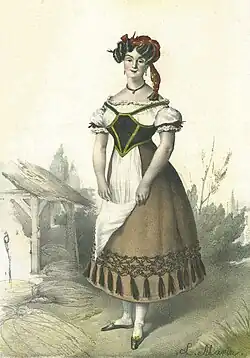
Marie-Julie Boulanger, née Marie-Julie Halligner (29 January 1786 – 23 July 1850), was a French mezzo-soprano.[1] She performed her entire career under the stage name Mme Boulanger, appearing in the world premieres of Le maître de chapelle, L'ambassadrice, Le domino noir, and La fille du régiment.
Biography
Born in Paris,[2] her parents were middle-class shopkeepers.[3] She was the older sister of Sophie Halligner, an actress at the Odéon-Théâtre de l'Europe and the Théâtre de l'Ambigu-Comique who had married the actor Frédérick Lemaître in 1826.[4] Halligner entered the Paris Conservatory in 1806 to study solfeggio;[2] she was a pupil of Charles-Henri Plantade and Pierre-Jean Garat.[5]
Halligner's debut at the Opéra-Comique in 1811 was considered "an immense success". A notable soubrette at the Opéra-Comique between 1811 and 1835, she continued performing until 1845, though her voice had started to fail her in the later years.[5] She performed in the world premieres of numerous opéras comiques, including Lady Pamela in Auber's Fra Diavolo in 1830[1] and Ritta in Hérold's Zampa in 1831.[6] She played the role of Gertrude in Le maître de chapelle, by Ferdinando Paer, 1821; Madame Barneck in L'ambassadrice, by Daniel Auber, 1836; and the Marquise of Berkenfield in La fille du régiment by Gaetano Donizetti, 1840. Her other performances included the works of André Grétry, Nicolas Isouard, François-Adrien Boieldieu.[7] Her voice was reportedly "fine, her execution brilliant and her acting full of character and intelligence."[8] After retirement in 1845, she concentrated on teaching activities in Paris.[7]
Halligner was the wife of cellist and professor of the Paris Conservatory, Frédéric Boulanger, whom she had met during her studies there. Her son, Ernest Boulanger, winner of the Grand Prix de Rome in 1835,[9] was a composer of comic operas; her daughter-in-law, Princess Raissa Mychetsky, descended from St. Mikahil Tchernigovsky.[10] Her granddaughters, Nadia Boulanger and Lili Boulanger, also competed in the Prix de Rome, Nadia earning second place in 1908 and Lili taking the first prize in 1913.[9]
References
- 1 2 Meyerbeer, Giacomo; Letellier, Robert Ignatius (1999). The Diaries of Giacomo Meyerbeer: 1791–1839. Fairleigh Dickinson Univ Press. p. 106. ISBN 978-0-8386-3789-0. Retrieved 24 April 2012.
- 1 2 Kendall, Alan (1976). The tender tyrant, Nadia Boulanger: a life devoted to music : a biography. Macdonald and Jane's. p. 4. ISBN 9780356084039. Retrieved 28 April 2012.
- ↑ Huyghe, René (1982). Lili et Nadia Boulanger (in French). La Revue Musicale. p. 71. Retrieved 28 April 2012.
- ↑ Tamvaco, Jean-Louis; Guest, Ivor Forbes (2000). Les cancans de l'Opéra (in French). CNRS editions. p. 611. ISBN 978-2-271-05742-6. Retrieved 28 April 2012.
- 1 2 Grove, Sir George (1904). Grove's Dictionary of Music and Musicians (Public domain ed.). Macmillan Company. pp. 371–. Retrieved 28 April 2012.
- ↑ Zampa libretto, 1831 at Google Books.
- 1 2 Castellani, Giuliano (2008). Ferdinando Paer: Biografia, Opere E Documenti Degli Anni Parigini (in Italian). Peter Lang. pp. 364–. ISBN 978-3-03911-719-2. Retrieved 28 April 2012.
- ↑ Grove, George; Fuller-Maitland, John Alexander. A Dictionary of Music and Musicians (A. D. 1450–1889). Forgotten Books. p. 263. ISBN 978-1-4400-6429-6. Retrieved 24 April 2012.
- 1 2 Dunbar, Julie C. (17 December 2010). Women, Music, Culture: An Introduction. Taylor & Francis. p. 218. ISBN 978-0-415-87562-2. Retrieved 24 April 2012.
- ↑ Campbell, Don G. (August 1984). Master teacher, Nadia Boulanger. Pastoral Press. p. 17. ISBN 978-0-912405-03-2. Retrieved 28 April 2012.